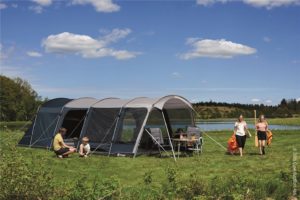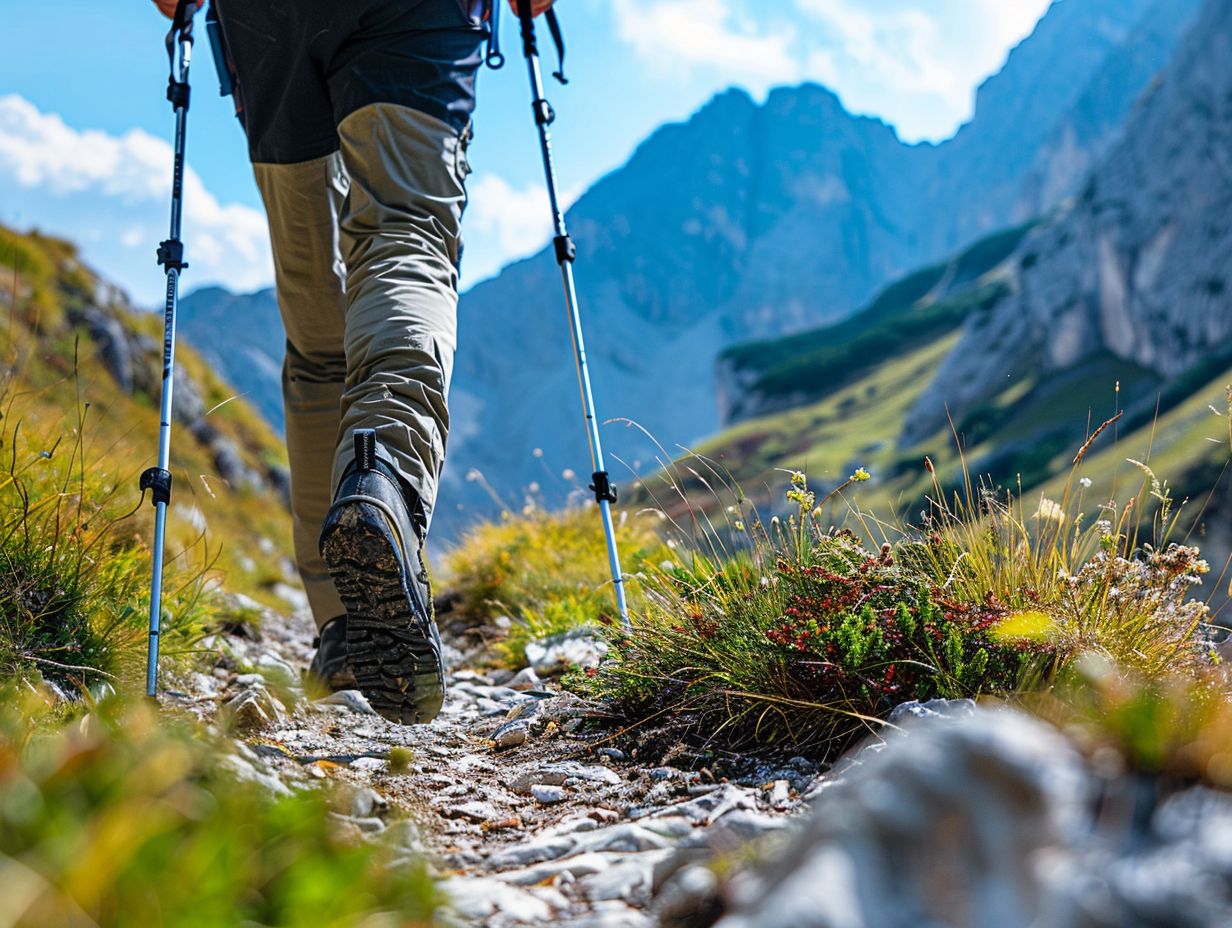

Vaibhav
- Categories: Hiking
Are you looking to enhance your hiking experience and improve your performance on the trails? Hiking poles may be the answer you’ve been searching for.
From reducing strain on your joints to providing extra support on challenging terrain, these versatile tools offer a wide range of benefits. We’ll explore the various advantages of using hiking poles, as well as when and how to use them effectively.
Whether you’re tackling steep inclines or crossing streams, hiking poles can be a valuable asset on your outdoor adventures. Let’s discover how these essential tools can take your hiking game to the next level.
Key Takeaways:

- Hiking poles can reduce strain on joints, improve balance, increase endurance, and provide extra support on difficult terrain.
- Hiking poles are best used during uphill and downhill hiking, crossing streams or rivers, and hiking with a heavy backpack.
- To use hiking poles properly, adjust the length, have proper hand placement and arm swing, and use the wrist straps.
What Are the Benefits of Using Hiking Poles?
The use of walking poles during hiking offers a variety of benefits, such as:
- Reducing strain on one’s joints
- Improving balance and stability
- Increasing stamina
- Providing extra support when traversing challenging terrain
1. Reduces Strain on Joints
The research conducted by Michael Torry from Western Illinois University indicates that trekking poles play a significant role in alleviating the strain on joints during physical activity.
When engaging in trekking or hiking activities, the utilization of trekking poles serves to distribute weight more uniformly across the body, effectively reducing the pressure on the legs and joints. This distribution of weight is facilitated by the poles acting as supplementary points of contact with the ground, enhancing stability and balance during movement.
Various studies have demonstrated that trekking poles not only improve stability but also reduce the impact on the knees by as much as 25%. It is advised by experts to use trekking poles that are properly adjusted to maximise these advantages, thereby ensuring a comfortable and efficient trekking experience.
2. Improves Balance and Stability
Hiking poles play a vital role in enhancing balance and stability on uneven terrain, as demonstrated by the experiences of hiker Christopher Knight on the Pacific Crest Trail. Christopher Knight, a seasoned hiker, frequently recalls the utility of hiking poles in providing additional points of contact with the ground, particularly on rough or slippery surfaces.
These poles not only improve stability but also lessen the strain on the knees during both uphill and downhill treks. Numerous experienced hikers attest to the advantages of using poles to distribute weight more uniformly, facilitating a smoother and safer journey through demanding terrains.
3. Increases Endurance
The utilisation of trekking poles can enhance hiking endurance by involving the arms and distributing effort more evenly across the body, as observed by long-distance hiker Justin ‘Trauma’ Lichter during his time on the Appalachian Trail.
By engaging the arm muscles while hiking, individuals not only receive added support and stability but also alleviate strain on the legs, ultimately leading to reduced fatigue.
Professional trainers frequently recommend integrating trekking poles into one’s hiking regimen to achieve a more balanced muscle engagement, ultimately resulting in enhanced overall endurance during prolonged treks.
Numerous seasoned hikers have relayed how increasing reliance on arm engagement during hikes has notably improved their stamina and comfort, particularly when traversing extended distances across diverse terrain.
4. Provides Extra Support on Difficult Terrain
Hiking poles serve as valuable tools to provide additional support when encountering challenging terrains, whether one is navigating rocky trails or utilising snowshoes in wintry conditions. When trekking across rocky terrains, the unpredictable and uneven surfaces can exert strain on one’s joints and necessitate enhanced balance.
Hiking poles play a crucial role in distributing weight uniformly, thereby alleviating pressure on the knees and furnishing stability while traversing demanding landscapes. In a similar vein, during the winter season when engaging in snowshoeing activities, hiking poles serve to offer supplementary support by aiding in maintaining equilibrium on slick snow and icy surfaces.
By complementing snowshoes with hiking poles, not only is stability enhanced, but propulsion forward in deep powder or on steep inclines is facilitated, rendering winter excursions safer and more gratifying.
When Should You Use Hiking Poles?
Understanding the appropriate circumstances for utilising hiking poles can significantly impact one’s hiking experience, particularly when navigating uphill terrain, descending steep slopes, crossing bodies of water, or carrying a substantial rucksack load.
1. Uphill Hiking
When trekking uphill, the use of poles can be helpful in engaging the arms, thereby facilitating the ascent and reducing the strain on the legs. This division of effort between the arms and legs enhances the maintenance of balance and stability on steep slopes.
Moreover, the poles provide additional support and assist in moving forward, easing the load on the leg muscles. Adopting this technique allows for the conservation of energy and stamina, leading to a more effective and enjoyable hiking trip.
Moreover, the inclusion of poles can lessen the impact on joints, especially during descents, by offering additional support and cushioning. By adding poles to the hiking routine, one can improve performance and reduce the physical strain on the body.
2. Downhill Hiking

When engaging in downhill hiking, trekking poles play a critical role in providing support by improving balance and lessening the impact on one’s joints.
To optimise the use of trekking poles during downhill hikes, it is essential to ensure they are adjusted to the correct length based on individual height – typically resulting in a 90-degree angle at the elbow when holding the poles.
Positioning the poles slightly in front of the body while descending can aid in maintaining stability and regulating movement. Emphasising a rhythmic pattern and alternating arm movements with each step can help evenly distribute weight and alleviate pressure on the knees.
By involving the upper body in this manner, the strain on the lower body, particularly the knees, is notably reduced, resulting in a more comfortable and secure descent.
3. Crossing Streams or Rivers
Hiking poles serve a crucial purpose when traversing streams or rivers by offering extra points of balance to mitigate the risk of slipping. Along with providing stability, these adaptable tools can serve to assess the depth and stability of the riverbed before engaging in the crossing.
By methodically probing the water with the pole, hikers can accurately determine the depth and identify any potential hazards that may be concealed beneath the surface.
The secure grip of the poles on the riverbed aids in maintaining stability while evaluating the firmness of the footing. Employing this straightforward yet effective technique can significantly bolster safety measures and instil confidence when manoeuvring through water obstacles during outdoor pursuits.
4. Hiking with a Heavy Backpack
The utilisation of trekking poles during hiking expeditions with a substantial rucksack confers additional support and facilitates the even distribution of weight, thereby enhancing endurance. When hikers employ poles, they can mitigate strain on their joints and muscles, particularly when traversing challenging topography.
It is imperative to adjust the length of the poles to align with one’s height to ensure proper reinforcement – endeavour to maintain a 90-degree angle in the arms while gripping them.
Adhering to the correct technique, such as positioning the poles slightly in front and to the side of the body, can augment stability and equilibrium when transporting heavy loads. These minor modifications can yield a notable impact on the overall comfort and efficiency of the hiking experience.
How to Use Hiking Poles Properly?
The correct utilisation of walking poles necessitates:
- Adjusting the length to accommodate the terrain,
- Ensuring proper hand placement,
- Executing an efficient arm swing, and
- Making use of wrist straps for optimal support.
1. Adjusting the Length
Proper adjustment of hiking poles is essential for effectively navigating various types of terrain. When encountering uphill terrain, it is advisable to slightly shorten the poles to facilitate the ascent. This adjustment promotes a more comfortable posture and enhances the engagement of upper body muscles.
Conversely, when traversing downhill sections, extending the poles can offer increased support and stability. On flat terrain, maintaining the poles at a standard length that permits a natural arm swing, without inducing strain, is recommended. It is essential to approach adjustments gradually and engage in experimentation to determine the optimal length for each specific type of terrain.
2. Proper Hand Placement
Correct hand positioning on hiking poles is essential for a secure grip and efficient use. To achieve the best grip and comfort, it is recommended to place your hands on the poles near the top grips, with your fingers gently wrapping around the handles. It is important to avoid excessive tightness in your grip, as this can result in hand fatigue and discomfort, particularly during extended hikes.
Additionally, keeping your wrists in a neutral position is advisable to prevent strain, and adjusting the straps to offer support without causing constriction is crucial. By maintaining a relaxed grip and allowing your hands to move naturally with each step, you can enhance your overall hiking experience and reduce the likelihood of hand strain.
3. Proper Arm Swing
Maintaining balance and rhythm during a hike can be greatly aided by utilising appropriate arm swing techniques while using hiking poles. When traversing uphill terrain, it is advisable to focus on keeping your elbows slightly bent and engaging in shorter arm swings to effectively propel yourself forward.
Ensuring that your arm movements are synchronised with your leg movements is crucial; coordinating the swinging of your arms with each step can optimise your hiking performance.
Conversely, when descending downhill, a more liberal and expansive arm swing can contribute to stability and balance. Adopting a relaxed arm swing that aligns with your pace is recommended for a leisurely stride, while a swifter pace may necessitate faster arm movements to facilitate efficient forward propulsion.
By understanding and applying these arm swing techniques in varying hiking conditions, hikers can enhance their hiking experience and performance.
4. Using the Wrist Straps
Proper utilisation of the wrist straps on hiking poles can offer additional support and alleviate hand fatigue.
When donning the wrist straps, it is imperative to ensure they are adjusted to fit snugly around the wrists without being overly tight. This adjustment aids in the more effective distribution of weight from the poles and prevents them from slipping off the hands.
A common error to be avoided involves wearing the straps with excessive looseness, as this negates their intended purpose of providing support. It is crucial not to rely exclusively on the wrist straps for stability but rather to consider them as a supplementary aid to your grip on the hiking poles.
By employing wrist straps correctly, individuals can augment their hiking experience, rendering it more comfortable and enjoyable.
What Are the Different Types of Hiking Poles?

There are a variety of hiking poles on the market, such as telescopic poles, folding poles, and fixed-length poles, each presenting distinct advantages to cater to various hiking needs.
1. Telescopic Poles
Telescopic poles are characterised by their adjustable nature, allowing users to extend or retract them to accommodate both the terrain and individual preferences. These poles offer a multitude of advantages to hikers, including enhanced stability on uneven surfaces, reduced stress on joints during descents, and increased overall endurance.
To maximise the benefits of telescopic poles, it is essential to first adjust them to the appropriate height based on the specific conditions of the terrain. Shortening the poles is advisable for uphill ascents as it enables more efficient engagement of the upper body. Conversely, lengthening the poles is recommended for downhill descents to alleviate pressure on the knees.
Renowned models such as the Black Diamond Trail Ergo Cork and the Leki Micro Vario Carbon are celebrated for their robust construction and ergonomic design, rendering them suitable choices for a variety of hiking expeditions.
2. Folding Poles
Folding poles exhibit characteristics of compactness and ease of transport, rendering them advantageous for travel purposes and convenient storage when not actively utilised. These poles specifically cater to hiking enthusiasts who value the ability to condense the poles into a smaller form factor for situations where their immediate use is unnecessary.
The inherent portability of folding poles give the power tos adventurers to effortlessly store them within a backpack or externally attach them without occupying substantial space.
In the process of procuring folding poles, it is prudent to account for various considerations such as adjustable height to facilitate personalised adjustments, durability to withstand rugged terrains, and ergonomic handles to ensure a comfortable and secure grip.
To optimise the utility derived from folding poles, it is imperative to configure them to the correct length to achieve optimal stability, while also employing the wrist straps to mitigate strain on the arms during prolonged hikes.
3. Fixed-length Poles
Fixed-length poles provide enhanced stability and are the preferred choice for hikers who do not require adjustable lengths. These poles are particularly advantageous for individuals who prioritize a lightweight and uncomplicated design for their outdoor excursions.
When choosing the appropriate length for fixed poles, it is essential to take into account your height and the type of terrain you will be traversing. Opting for poles that are slightly shorter than traditional adjustable ones can result in improved control and efficiency.
Fixed-length poles are particularly well-suited for activities such as trail running, where maintaining a consistent length is crucial for sustaining a steady pace and rhythm.
What to Look for When Choosing Hiking Poles?
When selecting hiking poles, it is crucial to take into consideration factors such as:
- Material composition
- Weight
- Grip and strap design
- Shock absorption capabilities
- Pricing
in order to identify the most suitable option based on your requirements.
1. Material
The durability and weight of hiking poles are influenced by the material from which they are constructed, with common options consisting of aluminium and carbon fibre. Aluminium poles are recognised for their robustness and cost-effectiveness in comparison to carbon fibre varieties, making them a suitable selection for novice hikers or individuals with budget constraints.
Conversely, carbon fibre poles are characterised by their lightweight nature and superior shock absorption, rendering them well-suited for extended hikes or hikers seeking to mitigate fatigue. In instances where hiking on rugged terrain necessitates frequent adjustments, the durability of aluminium poles may render them more appropriate.
Conversely, for backpackers aiming to minimise weight during prolonged excursions, carbon fibre poles are commonly favoured.
2. Weight
The importance of the weight of hiking poles cannot be overstated when considering comfort during extended hikes, as lighter options can significantly reduce fatigue.
When choosing hiking poles, it is imperative to strike a balance between weight, durability, and stability. Opting for lightweight poles can play a pivotal role in alleviating strain on the arms and shoulders, thereby enabling hikers to cover longer distances with less exertion.
Furthermore, the durability of hiking poles should be carefully evaluated, particularly for individuals traversing rugged terrains or embarking on lengthy backpacking excursions. Materials such as carbon fibre or aluminium are recommended due to their optimal blend of lightness and robustness.
Ensuring stability is paramount to enhancing support and balance on uneven trails, underscoring the importance of selecting poles equipped with dependable locking mechanisms and ergonomically designed grips.
3. Grip and Strap
The design of hiking poles’ grip and strap plays a crucial role in enhancing comfort and control during a hiking excursion. Various types of grips and straps can have a significant impact on the hiking experience.
For example, ergonomic grips featuring padding can mitigate hand fatigue and offer a more comfortable hold. Adjustable straps aid in distributing weight evenly and can prevent wrist strain. Cork and foam grips provide varying levels of cushioning and possess moisture-wicking properties.
When selecting hiking poles, it is advisable to opt for those equipped with shock-absorbing technology to minimise the impact on joints. It is essential to ensure that the grip’s size and shape are suitable for your hand, as this can improve your overall hiking performance.
4. Shock Absorption

Hiking poles equipped with shock absorption features serve to significantly diminish the impact on joints, particularly when navigating rugged terrain.
The incorporation of springs or alternative mechanisms within the poles enables them to absorb and disperse the force generated during hiking. This functionality not only enhances comfort but also serves to mitigate the risk of sustaining injuries and experiencing fatigue.
Leading models such as the Black Diamond Trail Shock and Leki Micro Vario Carbon are renowned for their exceptional shock absorption capabilities, rendering them well-suited for extended treks or demanding trails.
By alleviating strain on the knees and wrists, these poles contribute to improved stability and endurance, ensuring a more enjoyable and sustainable outdoor experience.
5. Price
The cost is a crucial factor to consider when selecting hiking poles, as it must align with your budget while also fulfilling your requirements. When exploring cost-effective alternatives, aluminium or composite materials may be preferable to carbon fibre due to their lower pricing.
In the lower price brackets, it is advisable to prioritize fundamental characteristics such as adjustable height, ergonomic grips, and durable tips. As one progresses to higher price tiers, additional features like shock absorption, anti-shock mechanisms, and adjustable wrist straps may be included.
It is imperative to evaluate your specific hiking prerequisites and ascertain which features hold the utmost significance, striking a balance between cost and functionality in order to procure the ideal hiking poles for your outdoor excursions.
Frequently Asked Questions
What are the benefits of using hiking poles?
Hiking poles offer numerous benefits, including increased stability, improved balance, reduced strain on joints, and an upper body workout.
When should I use hiking poles?
Hiking poles are especially useful when hiking on uneven terrain, steep inclines, or when carrying a heavy backpack. They can also be helpful for long hikes or multi-day treks.
How do I use hiking poles?
Start by adjusting the poles to the correct height for your body. When hiking, use the poles to create a natural rhythm, planting them on the ground with each step. Use them to assist with balance and take some of the weight off your legs and knees.
Do hiking poles really reduce strain on joints?
Yes, hiking poles can reduce strain on joints by up to 25%. They act as shock absorbers, taking some of the impact off your knees, ankles, and hips while hiking on hard or rocky surfaces.
Can I use hiking poles in all types of weather?
Yes, hiking poles can be used in all types of weather. They provide added stability and balance in wet or slippery conditions and can also be used to test the depth of snow or mud before stepping on it.
Do I need to bring hiking poles on every hike?
It is not necessary to bring hiking poles on every hike, but they can be useful for most types of terrain and weather conditions. It is always a good idea to bring them along, especially if you are hiking for long distances or on challenging trails.
Share:
By submitting your email address, you are agreeing to receive marketing emails from theexpertcamper.co.uk.
We’ll never share your email address and you can unsubscribe at any time. Privacy policy
Related Posts

A Seasonal Guide To Hiking In The Peak District
Are you ready to lace up your hiking boots and explore the stunning landscapes of the Peak District? This seasonal guide will take you through

Hiking Challenges Preparing For Your First Ultrahike
Are you ready to take your hiking adventures to the next level? Ultra-hiking offers a unique combination of physical and mental challenges, breathtaking scenery, and

Ecofriendly Hiking Tips For Sustainable Adventures
Are you an outdoor enthusiast looking to minimise your impact on the environment while enjoying the great outdoors? Eco-friendly hiking is the perfect solution! We

The Best Hiking Trails For Experiencing UK Wildlife
When exploring the picturesque hiking trails of the UK, you can expect to encounter a diverse array of wildlife. From majestic birds soaring overhead to

Wildflower Walks The Best Trails For Nature Lovers
Are you a nature lover looking to embark on a wildflower walk? Explore the best trails for wildflower walks, including [Trail Name 1], [Trail Name

























